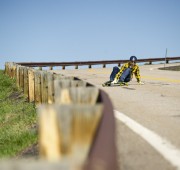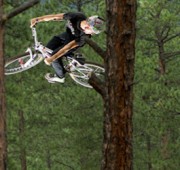Image Breakdown: Teva Biker Jump
I've said it before, and I'll say it again…. Competitions are possibly the best way to experiment and capture tons of amazing angles. They allow you to shoot the top tier athletes on all kinds of features and provide great accessibility. That being said, if you haven't had a chance to shoot one yet, I highly recommend finding the next competition for the sport you would like to shoot and trying to gain press access for even better angles.
For this image I wanted to combine the natural sunset light, as the sun went down to the right, with a flash under and to the left of the athlete. This way the flash would fill in the athletes face and the overly shadowy spots. I scoped all the different angles before the event started and took a quick snapshot of each one to look through as I decided which was the most exciting.
I also knew that the athletes were not really spinning or doing flips off this feature, so it would not work as well to shoot from behind since I would not capture their expression as they hit the feature. Capturing a person's face is very important in almost any image since it gives more feeling to the moment and shows excitement.
One of the aspects that I loved most, was the aspen trees that were perfectly framed in by much darker pine trees in the background. I moved around until the jump was centered within the aspens so the athlete would have that nice bright green behind them. This also meant that I would have to take lots of shots because I needed an athlete that had on a bright jersey that would contrast nicely with the background. Sometimes it's best to wait for all the elements to stack up perfectly when you know you have a great angle.
Not only did I need someone in a bright jersey to hit the feature, I also needed them to throw a trick that looked stylish and still showed their face. This is another element that I kept shooting this same angle to achieve.
For the lighting, I had an Alienbees B1600 off to the left and under the athlete, set to about 1/2 power and triggered with a PocketWizard Mini TT1 and a Plus II receiver. This technique works really well for shooting daylight flash shots. Simply set up a flash under a jump and off to the opposite side of the sun and you can achieve a very edgy looking image with light from both sides, while still filling in the face that is often in shadows caused by the helmet.
Don't get overly caught in lighting first however. Focus on your angle and composition, then add in the lights in a location where they won't get in your way. If you set up lighting first it's easy to spend too much time working around where your lights are, and you'll pass on great angles simply because you don't want to move the flashes and change the lighting. I composed this shot around the rule of thirds, with the athlete toward the top and right of the frame, the feature in the middle third to show where he came from, and the landing in the bottom third to show where he's going. Composing with all these elements puts the whole story together, even if the story is rather simple like this one (athlete jumping).
My camera settings were: ISO 800, 1/1250th shutter speed at f/8 to help get the trees a bit more in focus. I achieved 1/1250th flash sync speed by using a PocketWizard MiniTT1 on my camera in hypersync mode and Plus II receiver.
Now get out there and start shooting! Experimenting with all kinds of different lighting and compositions is what photography is all about, just don't get too caught up in things or you won't have any fun!











on
Man, I love your site! Thanks for all the time that you put into helping others out with these posts. I shoot a lot of very similar sports with some of the same equipment and it’s been fun seeing how you do things. Keep up the good work!
on
Thank you very much! I'm glad you like the site and Daniel and I are very happy to hear that our posts are helping you out. Please let us know if you ever have any article requests.